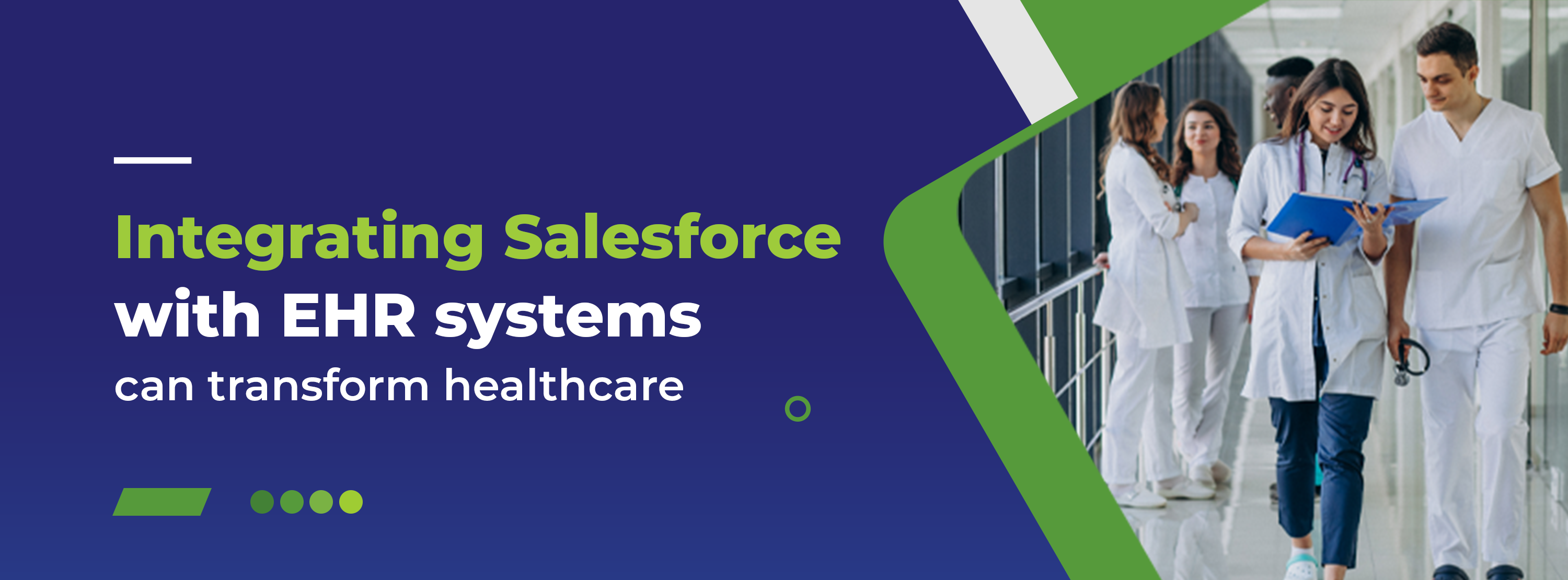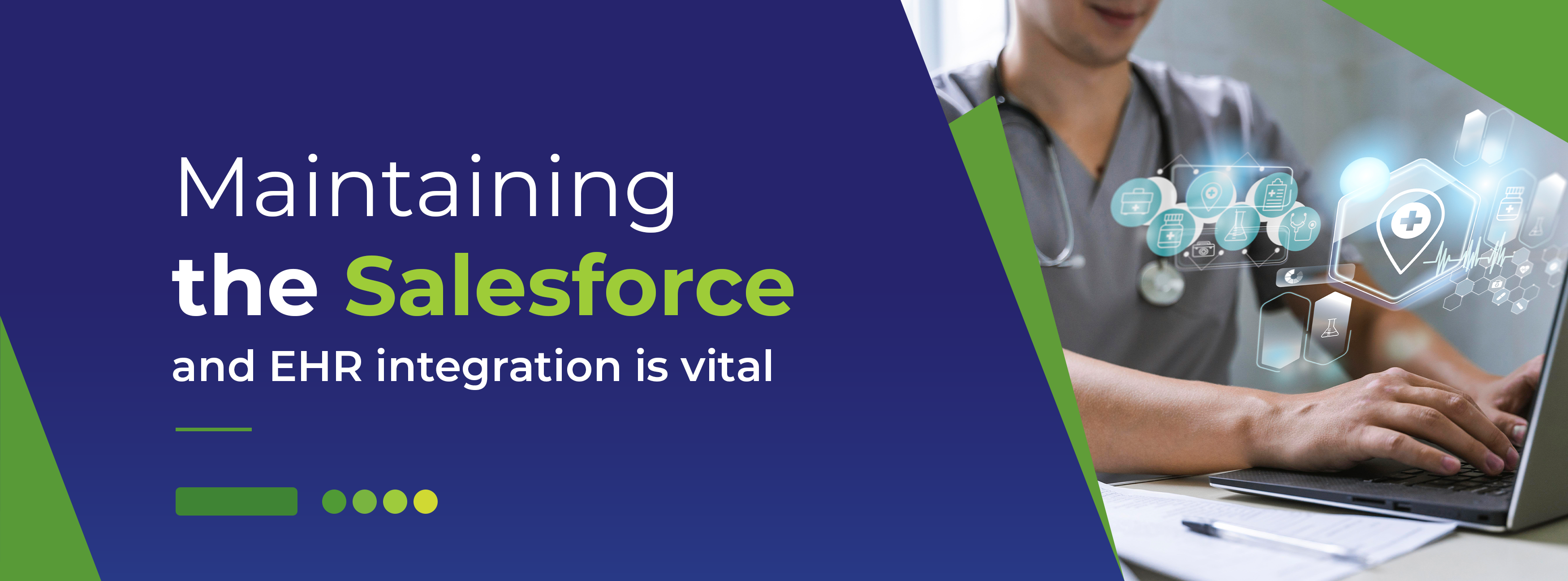A Detailed Guide to Having a Successful Salesforce and EHR Integration

Preparing for Integration
Integrating Salesforce with EHR systems can transform healthcare. Yet, seamless integration demands careful planning and a solid grasp of both platforms. Here's a roadmap to guide you:
A. Establish Clear Objectives and Requirements
Before embarking on the integration journey, clearly understanding what you aim to achieve is crucial.
- Identify the Use Case: Decide the specific scenario you want to integrate into Salesforce. This could include:
- Automating the management of high-risk patients.
- Implementing collaborative care planning.
- Engage a Diverse Team: Collaborate with a mix of business and clinical owners and IT specialists to develop the use case.
- Determine Required Data: Based on the use case:
For managing condition-specific patients, gather data on problems, diagnoses, or health issues for all patients.
- Source Systems Identification: Determine which systems, like the EHR or other relevant platforms, are needed for the integration.
- Data Directionality: Assess the flow of data:
Decide if it will be a one-way flow from the source system or a two-way exchange between systems.
- Middleware Consideration: Check if a middleware provider is facilitating the integration.
- Timeliness of Data: Determine how promptly you need to access the data.
B. Identify the right EHR System and S alesforce Edition
Selecting the right Electronic Health Record (EHR) system and Salesforce edition depends on your needs and requirements.
1. Understand Your Needs:
- Gauge the specific requirements of your healthcare organization, such as user count, medical specialties catered to, and mandatory regulatory compliances.
2. EHR System Selection:
- Opt for EHR systems that adhere to critical healthcare regulations, including HIPAA.
- Think about cloud-based EHR options for their scalability and accessibility advantages.
- Prioritize features like comprehensive patient records, efficient appointment management, streamlined billing, and seamless interoperability with other healthcare platforms.
3. Choosing the Right Salesforce Edition:
- Match the Salesforce edition to your organization's scale and requirements. Salesforce presents a range of editions like Essentials, Professional, Enterprise, and Unlimited.
- Weigh the pros and cons of each edition. For instance, while smaller entities might find Essentials apt, larger organizations might lean towards the Enterprise or Unlimited editions.
4. Integration Focus:
- Aim for a smooth integration between the EHR system and Salesforce to facilitate efficient data exchange.
5. Budget Considerations:
- Align your choices with your financial capacity, considering the varying costs of EHR systems and Salesforce editions.
6. Training Initiatives:
- Allocate resources for comprehensive training, ensuring your team can harness the full potential of both the EHR system and Salesforce.
7. Emphasize Security and Regulatory Adherence:
- Place paramount importance on data protection and adherence to healthcare norms. Both your EHR system and Salesforce edition should champion stringent security protocols.
8. Vendor Credibility:
- Investigate the reputation of both the EHR system provider and Salesforce. Review customer feedback, testimonials, and real-world case studies to assess their credibility.
9. Test Before Committing:
Check out for demos or trial versions to evaluate the practicality and fit of the EHR system and Salesforce edition for your operations.
10. Leverage Expertise:
Engage with healthcare IT specialists or consultants for personalized guidance and insights.

C. Assembling a Dedicated Integration Team
When integrating systems as intricate as EHR and Salesforce, the importance of a dedicated and skilled integration team cannot be overstated.
- Diverse Expertise: Form a team combining business stakeholders, clinical owners, and IT specialists to ensure a holistic approach to integration.
- Data and System Proficiency: The team should be adept at identifying essential data and be familiar with both the EHR and Salesforce systems to ensure seamless integration.
- Integration Strategy: Prioritize understanding the directionality of data flow, working with potential middleware providers, and ensuring timely data access for effective integration
Step-by-Step Integration Guide
A clear roadmap is essential whether you're merging EHR with Salesforce or another platform. Explore this step-by-step guide to ensure a smooth and successful integration journey.
-
Define Data Mapping and Alignment
-
Identify Data to be Synced: Understand the specific data points that must be integrated between EHR and Salesforce. This could range from patient demographics to their medical history.
-
Create Data Maps and Dictionaries: Develop a clear mapping of how data from the EHR will align with Salesforce fields. This ensures consistency and accuracy in data transfer.
-
-
Establish Robust Security and Compliance Measures
-
HIPAA Compliance Considerations: Given the sensitive nature of healthcare data, ensuring HIPAA compliance is paramount. This involves safeguarding patient information and ensuring only authorized personnel can access it.
-
Ensuring Data Encryption and Access Control: Data should be encrypted both at rest and in transit. Additionally, robust access control mechanisms should be in place to prevent unauthorized access.
-
-
Utilize Integration Tools and Middleware
-
Overview of Integration Tools and Platforms: Various tools are available for integration, such as eCloudsBridge™, which offers a modern approach to EHR integration. It provides an API and application integration platform, ensuring seamless data flow.
-
Choosing the Right Middleware Solution: Middleware acts as a bridge between EHR and Salesforce. Choosing a solution that supports healthcare-specific standards like HL7, MLLP, and FHIR is essential.
-
-
Configure API Settings
-
Setting Up APIs for Data Exchange: APIs enable real-time data exchange between systems. Ensure that the APIs used support the necessary healthcare data formats and protocols.
-
Authentication and Authorization: Implement robust authentication mechanisms to ensure only authorized systems and users can access the data.
-
-
Implement Data Synchronization
-
Real-time vs. Batch Processing: Decide whether data should be synced in real-time or batches. Real-time synchronization ensures immediate data availability, while batch processing might be more efficient for large volumes of data.
-
Handling Data Conflicts: Establish protocols to handle conflicts during data synchronization, ensuring data integrity.
-
-
Conduct Testing and Quality Assurance
-
Creating Test Cases and Scenarios: Before going live, create comprehensive test cases to cover all integration scenarios.
-
Ensuring Data Accuracy and Consistency: Regularly check the data on both platforms for consistency and accuracy.
-
-
Manage Deployment and Go-Live
-
Rollout Plan and Timeline: Develop a clear plan detailing the integration's rollout phases and expected timelines.
-
Monitoring System Performance: Post-integration, continuously monitor system performance to ensure smooth operations and quickly address any issues.
-

Post-Integration Maintenance
Maintaining the Salesforce and EHR integration is vital. It demands careful attention to data integrity, security, and compliance. Regular checks and updates ensure their seamless operation in healthcare.
A. Monitoring and Troubleshooting
- Regular Testing: It's essential to continuously test the integration to ensure data flows seamlessly between Salesforce and the EHR system. By doing so, any issues can be identified and resolved promptly.
- Data Quality: Regularly monitor the quality of data exchanged between the systems. Implementing data validation and cleaning processes can help in preventing errors or inconsistencies.
- Monitoring and Alerts: Proactively detect issues by setting up monitoring and alerting systems. This can include automated alerts for data anomalies or system errors.
B. Handling Updates and Upgrades
- Updates and Upgrades: Regularly update both Salesforce and the EHR system with the latest versions and patches. This not only ensures compatibility but also bolsters security.
- Vendor Support: Maintain a strong relationship with both Salesforce and EHR system vendors. Their support can be invaluable when navigating integration challenges.
- Comprehensive Testing: Before rolling out any major changes or updates, performing comprehensive testing in a staging environment is crucial. This helps in avoiding disruptions to live data.
C. Scalability Considerations
- Performance Optimization: Regularly monitor system performance. Optimize configurations to ensure efficient data exchange and minimize latency.
- Scalability: As your healthcare organization grows, so should your integration. Always consider future expansion and adaptability in your maintenance plan.
Why Choose eCloudsBridge™?
eCloudsBridge™ offers innovative integration through a top-tier iPaaS system that connects diverse platforms, revolutionizing system communication. With expertise in various EHR setups, eCloudsBridge™ ensures seamless healthcare system operations. The team comprises 45+ Salesforce-certified professionals dedicated to healthcare integration. eCloudsBridge™ provides tailored solutions, emphasizing both security and efficiency. It represents a leap in healthcare system integration, blending technology with healthcare excellence.
EHR integration, when enhanced by the capabilities of eCloudsBridge™, marks a monumental advancement in healthcare technology. Beyond mere integration, it's a transformative approach to patient care and data management. With eCloudsBridge™, step into a future where technological innovation aligns seamlessly with healthcare excellence.

Popular Post

A Complete Guide to Understanding Salesforce Sales Cloud

5 Things You Should Consider in Choosing Your Salesforce Implementation Partner

11 Key Benefits of CPQ Every Business Needs to Know

10 Most Common CRM Implementation Challenges that You Must Be Aware Of






